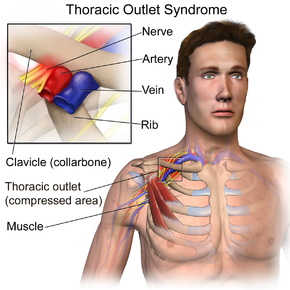Pathology of Cervicobrachialgia
Brachial plexus: some anatomy
The brachial plexus represents the nerve network responsible for innervation. Both sensory and motor, of the upper limb (the arm), which controls the muscles of the shoulder, arm, elbow, wrist, hand and fingers. These are nerve roots which, at the exit of the cervical spine, intertwine and branch to form the 5 main nerves of the upper limb and are:
- Musculocutaneous nerve
- Median nerve
- Ulnar nerve
- Axillary Nerve
- Radial nerve
According to the level of compression of the nerve root, the localization of the symptoms will change. Cervicobrachialgia C5 sees as its origin the nerve root present between the C4 and C5 vertebrae characterized by twitching in the biceps.
Cervicobrachialgia C6 affects the nerve root between C5 and C6 manifesting pain in the arm, forearm and thumb of the hand. Finally, cervicobrachialgia C7 sees pain manifest in the back of the arm, forearm up to the middle finger of the hand.
You May Be Interested In: Should I Use Ice or Heat For Neck Pain?
The Causes of Cervicobrachialgia
The most common cause of cervicobrachialgia remains nerve root compression caused by a cervical herniated disc or protrusion.
We can define the latter condition as one of the first stages of herniation. In this case the nucleus pulposus migrates outwards, but remains well trapped in the fibrous ring without damaging it. This growth can still press on the spinal cord or spinal nerves causing cervical and brachial pain. Cervical disc disease mainly affects the discs located between the C4-C5, C5-C6 and C6-C7 vertebrae, all vertebrae at the base of the neck. On the other hand, it is impossible for the C1-C2 vertebrae to suffer from this disorder since they do not have the intravertebral disc that could compress the nerve.
Causes of Shoulder pain radiating down arm to fingers
- Cervical herniation (or cervical disc herniation or cervical disc herniation).
- Cervical arthrosis.
- Rheumatoid arthritis.
- Congenital malformations of the spine.
- Cervical osteophytes.
- Trauma involving the cervical spine.
- Spinal neoplasms located along the cervical spine.
Thoracic Outlet Syndrome: Why It Causes cervical radiculopathy?
In human anatomy, the expression “thoracic outlet” refers to the physiological (therefore natural) narrowing delimited by the first rib, the clavicle, the scalene muscles (median and anterior), the subclavian muscle and the pectoralis minor muscle, inside which run the system of blood vessels artery – subclavian vein and the aforementioned brachial plexus.
In medicine, thoracic outlet syndrome is the name of the set of symptoms and signs deriving from the compression of blood vessels and/or nerve structures passing through the thoracic outlet.
Shoulder pain radiating down arm to fingers can be a consequence of thoracic outlet syndrome when the latter also involves compression of the nervous structures passing through it (and belonging to the brachial plexus).
In these circumstances, cervicobrachialgia is the result of a nerve compression located further downstream, compared to the situation described above (cervical radiculopathy); it is interesting, however, to point out to the reader that, despite this difference, the outcome is superimposable, including pain in the neck, shoulder and along the entire upper limb.
Causes of Thoracic Outlet Syndrome
The following causes/favor the thoracic outlet syndrome can be: congenital anatomical defects of the thoracic outlet, local trauma, postural anomalies (anteposed shoulders, winged shoulder blades , retraction of the pectoral muscles protraction of the cervical, etc.), obesity and the repetition of certain manual activities.
Symptoms
The symptom that characterizes how much pathology is the average pain that radiates from the neck to the hand. Symptoms usually manifest as pain in the right arm or pain in the left arm, hardly affecting both limbs. The neck is rigid in rotational movements. Shoulder and arm mobility also decreases.
The hand, on the other hand, presents with a very annoying tingling and/or paresthesia of some fingers. This condition also alters the sleep-wake rhythm, preventing the patient from staying in bed all night.
When the cause of cervicobrachialgia is a herniated disc, its compression on the nerves will cause:
- Numbness and tingling in the arm.
- Tingling in the hand and fingers.
- Tingling and numbness in the shoulder and the nearest portion of the chest.
- A sense of weakness affecting the deltoid muscle and the muscles, making up the rotator cuff (supraspinatus, infraspinatus, teres minor and subscapularis).
- Reduced ability to control the flexor muscles of the fingers of the hand.
- Difficulty in controlling the extensor muscles of the fingers of the hand.
- Generalized feeling of weakness along the painful upper limb (the hand feels heavy, as well as the forearm and arm).
- Stiffness in the neck.
- Dizziness and dizziness.
- Headache.
- Disturbed sleep (in many patients, the pain tends to increase at night, thus disturbing the night’s rest).
It should also be noted that patients with “shoulder pain radiating down arm to fingers” often have a greater susceptibility to sensorimotor stimuli on the whole body and in particular on the suffering upper limb, clearly when compared with individuals not affected by the same disorder.
Diagnosing Cervicobrachialgia
To diagnose cervicobrachialgia, in addition to a physical examination that involves a series of orthopedic and neurological tests, this pathology is confirmed by doing an MRI of the cervical spine. Before proceeding to the single diagnostic tests that can be performed, the doctor will analyze the overall picture by checking the strength, reflexes and amplitude of the movement of the arm.
If the pain radiating down the arm is caused by a herniated disc or a protrusion, the painful condition worsens when the neck is pressed or the limb is pulled, which allows the doctor to understand the pain and origin of symptoms.
Tests to detect The Pain
Some tests to understand the origin of pain include the Bakody tests (raising the arm above the head to decrease pain), Brudzinsky (cervical flexion while lying down), Jackson (which consists of seeing the response of the body by compressing the neck and placing it sideways). If the problem is caused by a herniated disc on the right side, the pain will only affect the right side of the body. Otherwise, if the protrusion or hernia presses on the nerves from the left side, the pain will affect only the left arm.
Very large and central hernias can cause symptoms in both arms, but also in the legs, a very rare condition. Among the tests most used to diagnose this disease are magnetic resonance and CT scans, which allow us to have a general and well-defined picture of the state of health of the intravertebral discs. Radiography, on the other hand, is not suitable, except in cases where a fracture or vertebral slipping is suspected.
Treatment
If there is a willingness to undergo therapy, the following measures can be considered:
Non-drug therapy
- Exercise and sport: Endurance sport and strength training, if done correctly, can improve the symptoms of cervical spine syndrome.
- Warmth: A hot water bottle wrapped in a towel and placed on the back of the neck has a beneficial effect, improves the skin’s microcirculation and alleviates pain.
- Physiotherapy and remedial gymnastics: In the case of cervical syndrome, individual remedial gymnastics or a few units of physiotherapy are very often prescribed, which must first be approved by the health insurance company. The exercises should be continued consistently at home in order to achieve success.
- Massage: Remedial massage performed by a physical therapist, in addition to physical therapy, can help loosen tight muscles (myogelosis).
- Acupuncture: Sessions with an acupuncturist can aid in the healing process. Just like biofeedback.
If you want have a free consultation with our physiotherapists click here please: Physical Therapy Services
Medical therapy
Pain killers only treat the symptoms of shoulder pain radiating down arm to fingers, but not the causes. If at all, medication should only be taken in low doses and over a short period of time after consultation with the doctor. Non-drug therapy using physiotherapy and remedial gymnastics has proven to be much more sensible.
FAQs
What Do Tingling and Numbness Cause?
Tingling and a sense of numbness along the upper limb are symptoms that depend on an alteration in the sensory component of the cervical spinal nerves (in particular, the suffering resides at the level of the roots or the immediately following nervous tract).
What Does Muscle Weakness Cause?
In the presence of cervicobrachialgia, muscle weakness of the upper limb is a symptom that depends on an alteration of the motor component of the cervical spinal nerves (as in the previous case, the suffering specifically concerns the roots or the immediately following nervous tract).
Bilateral cervicobrachialgia: is it possible?
As a rule, Shoulder pain radiating down arm to fingers is unilateral, that is, it affects only one side of the body.
However, in rare cases, it can also be bilateral, with the patient experiencing overlapping symptoms on both upper limbs.
Complications of Cervicobrachialgia
Failure to treat cervicobrachialgia leads to an aggravation of the symptomatological picture (eg: the pain becomes more intense, the tingling becomes unbearable, etc.), so that even the simplest manual activities (clearly with the limb) are difficult – if not impossible – superior concerned).
In such circumstances, the inability to perform the most trivial manual activities can have negative repercussions on the patient’s psychological sphere (discomfort, depression, mood decay, etc.).
Who to contact?
Figures in the medical-health sector who generally deal with a disorder such as shoulder pain radiating down arm to fingers are the orthopedist, the neurologist and the physiotherapist. Often, a collaboration between these professionals can help overcome the problem successfully.
References
https://www.jpain.org/article/S1526-5900(17)30371-1/abstract




